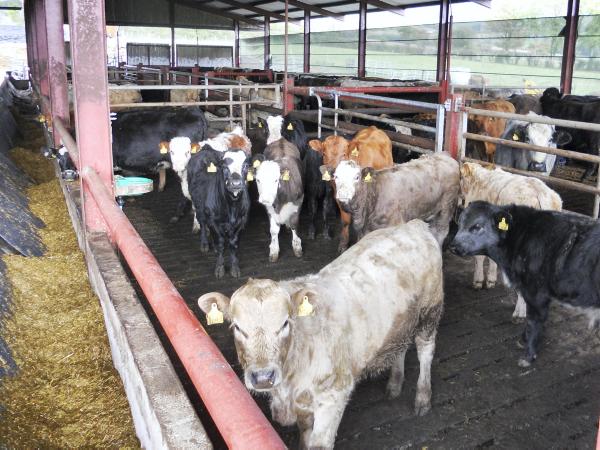This week, we feature part two of our winter management summary on the eight programme farms.
Alan Cairns Aghalee
Silage supplies should carry me through until the end of May. While stocks may not look large in volume, my silage has a very high dry matter, which means every grab, or bale, is lasting much longer and of a much higher value.
First cut analysed at 59.4% DM, 10.3ME and 8% protein. As this is the poorest of the silage, it is being given to dry cows.
I could get away with restricting this to 12.5kg per day, but in reality they are getting closer to 15kg. At £20/tonne, this is a daily cost of £0.30.
Cows are in ideal condition at the moment. Weanlings and finishing cattle are being fed second cut silage which is 41.5% DM, 10.3 ME and 13% protein.
The weanlings were eating 1.5kg per day at housing and then built up to 2.5kg per day of a 16% protein blend. Calves are performing really well but meal has been reduced back to 2kg and removed from the diet by late February.
Finishing cattle over 550kg have been built up to 7kg of a 13% protein and a high energy blend (13 ME) along with second cut silage. Most of these should be slaughtered by the end of January.
Trevor Wilson Parkgate
The fine weather this autumn has enabled some of the dry cows to remain out at grass much later than normal.
This has helped to reduce the overall silage demand. If young weanlings are able to be turned out early, I should be comfortable with silage supplies.
The autumn calving cows suckling August and September born calves are still with the stock bulls and are currently eating 40kg of first cut silage along with 2kg of a 16% protein blend which is just enough to sustain body condition.
This silage is 26.7% DM, 11.3 ME and 10% protein. Replacement heifers for this group are also being fed the same silage ad-lib, plus 2kg of the same blend.
The bulls were pulled out at the end of December at which point cows and heifers will be on silage only.
The June/July calving batch are on silage only with the calves eating almost 2.5kg of meal per day.
The bulls and heifers are mixed, but if I had the facilities I would have them separated as the heifers could probably do with only 2kg per day. These will be separated at weaning in late January.
Dry spring calving cows are being restricted silage to 30kg per day. The weanlings are on ad-lib silage plus 2.5kg per day.
John Milligan Castlewellan
I finished last winter with no silage reserves so took every opportunity this summer to ensile any surplus grass.
Based on current stock demand and if young stock can gradually be grazed from early spring, current silage stocks should carry me through.
Autumn cows have only recently been housed and are being fed first cut silage (19.2% DM, 12.7% protein, 10.5ME and 66 D-value) along with 2kg of a 16% protein ration. Meal will be taken off these cows as they settle in calf.
Weanlings are being fed ad-lib first cut silage along with 2kg of a 16% protein and high energy nut, which should achieve a weight gain of 0.7kg per day.
This should be an optimum gain to keep cattle growing without gaining fat cover and allow for good levels of compensatory growth at grass in spring.
Dry cows are being restricted to 30kg per day which is sufficient to maintain the current average body condition of just below 3.0. Replacement heifers due to calve next spring are eating ad-lib silage.
The remainder of the steers being finished in the new year are being built up from 3kg to 6kg of meal per day of a 13% high energy blend along with ad-lib silage.
Eamon McKeating Ballykinlar
Silage supplies are tight. All reserves were used up last spring and with grass growth suffering from the very dry weather, there were few opportunities to replenish these stocks.
I take one cut of silage which analysed 28% DM, 11.2% protein, 10.6 ME and 66 D-value. When all cattle are counted and a feed budget completed, I needed approximately 980 tonnes for a five-month winter.
I had silage stocks of 1,050 tonnes so have taken some action to reduce demand. One batch of 60 dry cows are being outwintered on ad-lib silage.
They are consuming 38kg per day, giving a daily feed cost of £0.76. Minerals are not fed in the feeders but mineralised lick buckets are available. In the past, all dry cows were outwintered, but this offered little opportunity to restrict intakes.
The remainder of the dry cows are housed and batched according to condition score. Those in good condition are being restricted to 70% of their intake.
Weanlings are all housed and being fed 2kg of meal per day, consisting mainly of rolled barley.
To reduce the demand for silage, I am increasing the meal fed to those cattle which will give me the best return from a high concentrate diet.
Therefore, I have reduced silage being fed to finishing cattle to 8.5kg per day along with 0.7kg straw with meal being built up to almost ad-lib.
This will also get cattle away earlier and should improve kill-out percentage.






 This is a subscriber-only article
This is a subscriber-only article











SHARING OPTIONS: